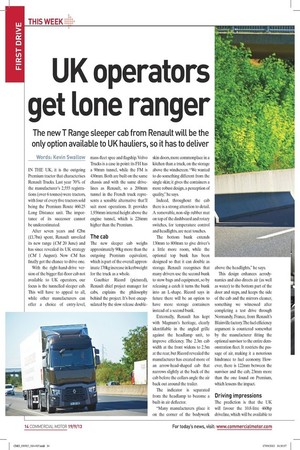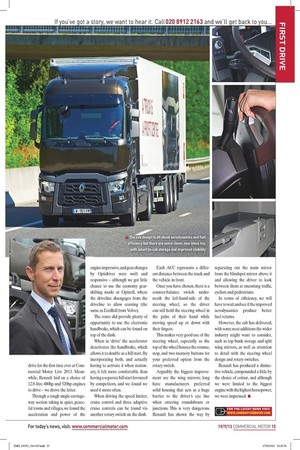UK operators get lone ranger
Page 9

Page 10

If you've noticed an error in this article please click here to report it so we can fix it.
The new T Range sleeper cab from Renault will be the only option available to UK hauliers, so it has to deliver Words. iwv.....,wvallow
IN THE UK, it is the outgoing Premium tractor that characterises Renault Trucks. Last year 70% of the manufacturer's 2,555 registrations (over 6 tonnes) were tractors, with four of every five tractors sold being the Premium Route 460.25 Long Distance unit. The importance of its successor cannot be underestimated.
After seven years and €2bn (£1.7bn) spent, Renault unveiled its new range (CM 20 June) and has since revealed its UK strategy (CM 1 August). Now CM has finally got the chance to drive one. With the right-hand-drive version of the bigger flat-floor cab not available to UK operators, our focus is the tunnelled sleeper cab. This will have to appeal to all, while other manufacturers can offer a choice of entry-level,
mass-fleet spec and flagship. Volvo Trucks is a case in point: its FH has a 90mm tunnel, while the FM is 430mm Both are built on the same chassis and with the same drivelines as Renault, so a 200mm tunnel in the French truck represents a sensible alternative that'll suit most operations. It provides 1,936mm internal height above the engine tunnel, which is 226mm higher than the Premium.
The cab
The new sleeper cab weighs approximately 90kg more than the outgoing Premium equivalent, which is part of the overall approximate 170kg increase in kerbweight for the truck as a whole. Gauthier Ricord (pictured), Renault chief project manager for cabs, explains the philosophy behind the project. It's best encapsulated by the slow release double
skin doors, more commonplace in a kitchen than a truck, on the storage above the windscreen. "We wanted to do something different from the single skin; it gives the containers a more robust design, a perception of quality," he says.
Indeed, throughout the cab there is a strong attention to detail. A removable, non-slip rubber mat on top of the dashboard and rotary switches, for temperature control and headlights, are neat touches.
The bottom bunk extends 130mm to 800mm to give driver's a little more room, while the optional top bunk has been designed so that it can double as storage. Renault recognises that many drivers use the second bunk to stow bags and equipment, so by releasing a catch it turns the bunk into an L-shape. Ricord says in future there will be an option to have more storage containers instead of a second bunk.
Externally, Renault has kept with Magnum's heritage, clearly identifiable in the angled grille against the headlamp unit, to improve efficiency. The 2.3m cab width at the front widens to 2.5m at the rear, but Ricord revealed the manufacturer has created more of an arrow-head-shaped cab that narrows slightly at the back of the cab before the collars angle the air back out around the trailer.
The indicator is separated from the headlamp to become a built-in air deflector. "Many manufacturers place it on the corner of the bodywork
above the headlights," he says.
This design enhances aerodynamics and also directs air (as well as water) to the bottom part of the door and steps, and keeps the side of the cab and the mirrors cleaner, something we witnessed after completing a test drive through Normandy, France, from Renault's Blainville factory. The fuel efficiency argument is countered somewhat by the manufacturer fitting the optional sunvisor to the entire demonstration fleet. It restricts the passage of air, making it a notorious hindrance to fuel economy. However, there is 122mm between the sunvisor and the cab, 23mm more than the one found on Premium, which lessens the impact.
Driving impressions
The prediction is that the UK will favour the 10.8-litre 460hp driveline, which will be available to
drive for the first time ever at Commercial Motor Live 2013. Meanwhile, Renault laid on a choice of 12.8-litre 480hp and 520hp engines to drive — we drove the latter. Through a tough single-carriageway section taking in quiet, peaceful towns and villages, we found the acceleration and power of the
engine impressive, and gear changes by Optidriver were swift and responsive — although we got little chance to use the economy gearshifting mode or Optiroll, where the driveline disengages from the driveline to allow coasting (the same as EcoRoll from Volvo).
The route did provide plenty of opportunity to use the electronic handbrake, which can be found on top of the dash.
When in 'drive' the accelerator deactivates the handbrake, which allows it to double as a hill start. By incorporating both, and actually having to activate it when stationary, it felt more comfortable than having a separate hill start favoured by competitors, and we found we used it more often.
When driving the speed limiter, cruise control and three adaptive cruise controls can be found via another rotary switch on the dash.
Each ACC represents a different distance between the truck and the vehicle in front.
Once you have chosen, there is a counter-balance switch underneath the left-hand-side of the steering wheel, so the driver can still hold the steering wheel in the palm of their hand while moving speed up or down with their fingers.
This makes very good use of the steering wheel, especially as the top of the wheel houses the resume, stop, and two memory buttons for your preferred option from the rotary switch. Arguably the biggest improvement are the wing mirrors; long have manufacturers preferred solid housing that acts as a huge barrier to the driver's eye line when entering roundabouts or junctions. This is very dangerous. Renault has shown the way by
separating out the main mirror from the blindspot mirror above it and allowing the driver to look between them at oncoming traffic, cyclists and pedestrians.
In terms of efficiency, we will have to wait and see if the improved aerodynamics produce better fuel returns.
However, the cab has delivered, with some neat additions the wider industry might want to consider, such as top bunk storage and split wing mirrors, as well as attention to detail with the steering wheel design and rotary switches. Renault has produced a distinctive vehicle, compounded a little by the choice of colour, and although we were limited to the biggest engine with the highest horsepower, we were impressed. •







































